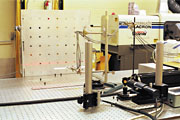
Small refrigerant gas leaks can seem to be elusive and a challenge to pinpoint. But now researchers at the University of Michigan, Ann Arbor, MI, have developed a device to maximize detection, accurately determining the location of extremely small gas leaks.
David Dowling, associate professor of mechanical engineering at the university, and student Serdar Yonak, are the co-inventors of this new technology. Their work was sponsored by the Ford Motor Co. in Detroit, and the automaker is now developing production equipment for such work as finding leaks in automotive air conditioners. (Yonak is now an employee of Ford.)
The technology makes use of photoacoustics, which is the excitation of acoustic waves by the momentary addition of heat from a light source.
Dowling and Yonak filled a container with sulfur hexafluoride (SF6) gas. Escaped gas from the container is heated instantly by light from a CO2 laser, causing it to expand rapidly and release an acoustic wave. By locating the sound, the device “detects the presence of gas at the leak,” said Dowling. The highest concentration of gas will be at the leak point.
The narrow laser beam scans the part more than 6,000 times per second and the test piece is thoroughly covered. The only way a leak could escape detection, he noted, would be if it’s on an interior surface not touched by the laser.
Dowling remarked that this detection technique is an expansion of the earlier work of Thomas McRae of Laser Imaging Systems, Punta Gorda, FL.
The invention uses multiple microphones, multiple signal frequencies, and matched-field processing to locate the leak source.
Using matched-field processing allows one to find a leak just from the sound, Dowling explained. Four microphones are positioned to hear the acoustic wave coming from the expanding gas. Applying software developed by Dowling and Yonak, and with the known location of the microphones and test part, a computer can simulate the acoustic environment.
The computer takes the sound heard and plays it backward into its model of the acoustic environment, related Dowling. Playing the sound backward allows calculation of an “acoustic retrofocus” at the spot of the leak.
The system has the capability to “localize a gas leak to ±1 mm in the lab,” he said. Virtually any size part can be tested with this method.
Because the process uses sound, background noise must be considered. Sound waves are compared against measured background noise.
Although it is a very precise device, it does not require any special operating conditions. It can be used at room temperature and pressure. And, “it can work in dirty environments,” Dowling stated. Tested as a fixed system, he said that it could be portable.
A patent is pending on this detection approach, and the university is seeking licensees to commercialize the invention.
For more information, contact the Technology Management Office of the University of Michigan at 734-936-1580.
Publication date: 01/29/2001


Report Abusive Comment